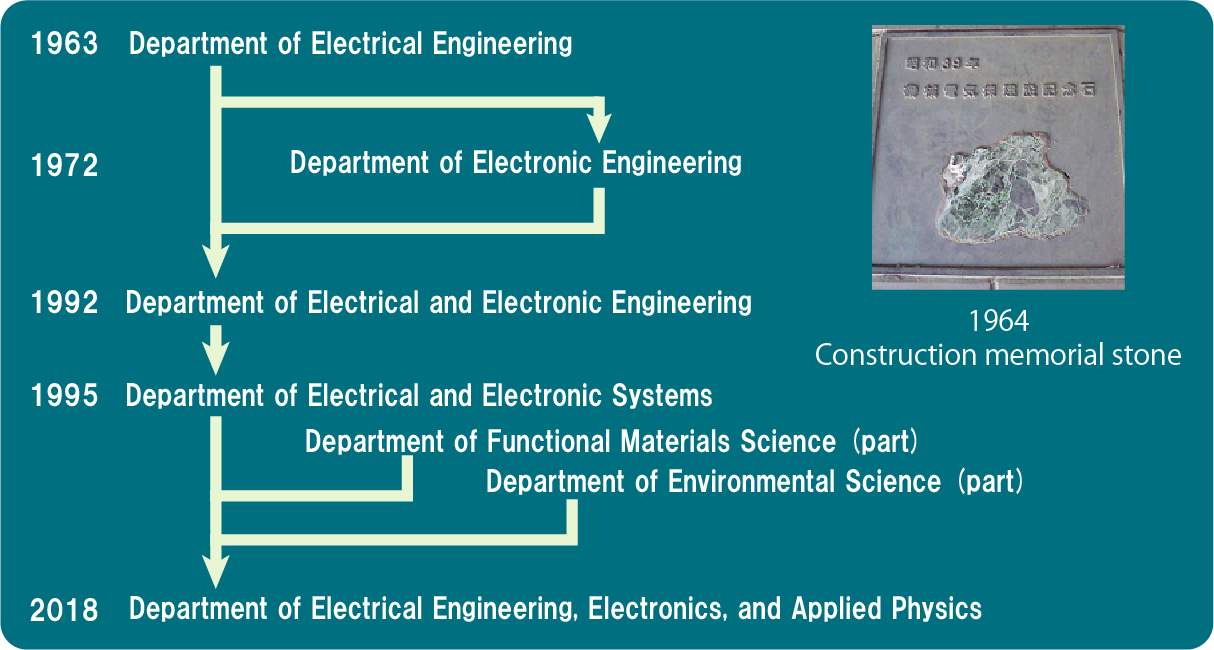A new department of electrical engineering, electronics, and applied physics (EEAP) starts from April 2018.
About EES
The electronic engineering and electronics have been developed surprisingly. In these days, electrical engineering and electronics are essential not only in industries but also in our daily living. The innovations in electronics provide us hardware such as computers, VLSI, optical fiber, and new materials, and have realized a highly sophisticated information-oriented society in cooperation with the growth of software technologies. Furthermore, the innovations in electrical engineering and electronics are about to introduce much more profit into our society in cooperation with other advanced technologies such as mechatronics.
Based on this circumstance and the needs of the era, Department of Electrical and Electronic Systems (EES) works on education and research on computer systems, VLSI circuit design, fundamentals on information and communication, artificial intelligence (AI), energy systems, and development and analysis of new semiconductor devices. In addition, the department makes efforts to contribute to the society by growing talented persons through education.
Five Features of EES
1. Attractive Electrical and Electronic Systems
- Traction of Japanese and World Industries
Electrical and electronic system techniques are required for semiconductor, consumer electronics, and automotive in addition to social infrastructure of electric power, communications, and railroad. Leading companies in every industry are hiring trented persons having university eduations in the area of electrical and electronic systems. - New Discoveries and New Techniques
Electrical and electronic system is one of the creative and energetic research areas, leading to new discoveries and new techniques with continuous amazing success. You can challenge on new frontier and enjoy success.
2. Best Learning Curriculum and Research Environments
- Small-Group Professional Learning (four students per one professor)
77 students in one grade for 8 professors, 8 associate professors, and 6 assistant professors. - Best Learning Curriculum through Theory, Experiment, and Practice
Our undergraduate curriculum is organized by establishing fundamental EES subjects togather with thier exercises to deepen your understanding. You can also learn proctice of the electrical and electronic engineering theory through related experiments with the assistance of professional technicians.
3. Successful Career
- Graduate Schools
In every year, more than 70% students go to graduate schools including Saitama University, Tokyo Tech., Todai and so on. - High Employment Success Rate
The job offer rate for EES graduates goes up to almost 100 percents.
4. Financial Aid
- Low School Fee
You can learn the state-of-art technologies of EES at about 540,000 yen per year. - Financial Aid
You have opportunities of gaining financial aid from Japan Student Services Organization (JASSO).
5. Quick Access to Tokyo
- Only 40 min. to Tokyo
You can access Tokyo in 40 min. to visit exhibitions and academic conferences. Quick access to Tokyo is one of advantanges for finding job in Tokyo. - All in One Campus
At Saitama University, all academic departments and graduate schools are located on a single campus. The geographical proximity naturally exposes students to multiple fields of academics and enables them to form diverse human networks.
History of Department of Electrical and Electronic Systems
- 1963: Establishment of Department of Electrical Engineering
- 1972: Derivation of Department of Electronic Engineering
- 1992: Merger into Department of Electrical and Electronic Engineering
- 1995: Reorganization to Department of Electrical and Electronic Systems
- 2018: Merger into Department of Electrical Engineering, Electronics, and Applied Physics




